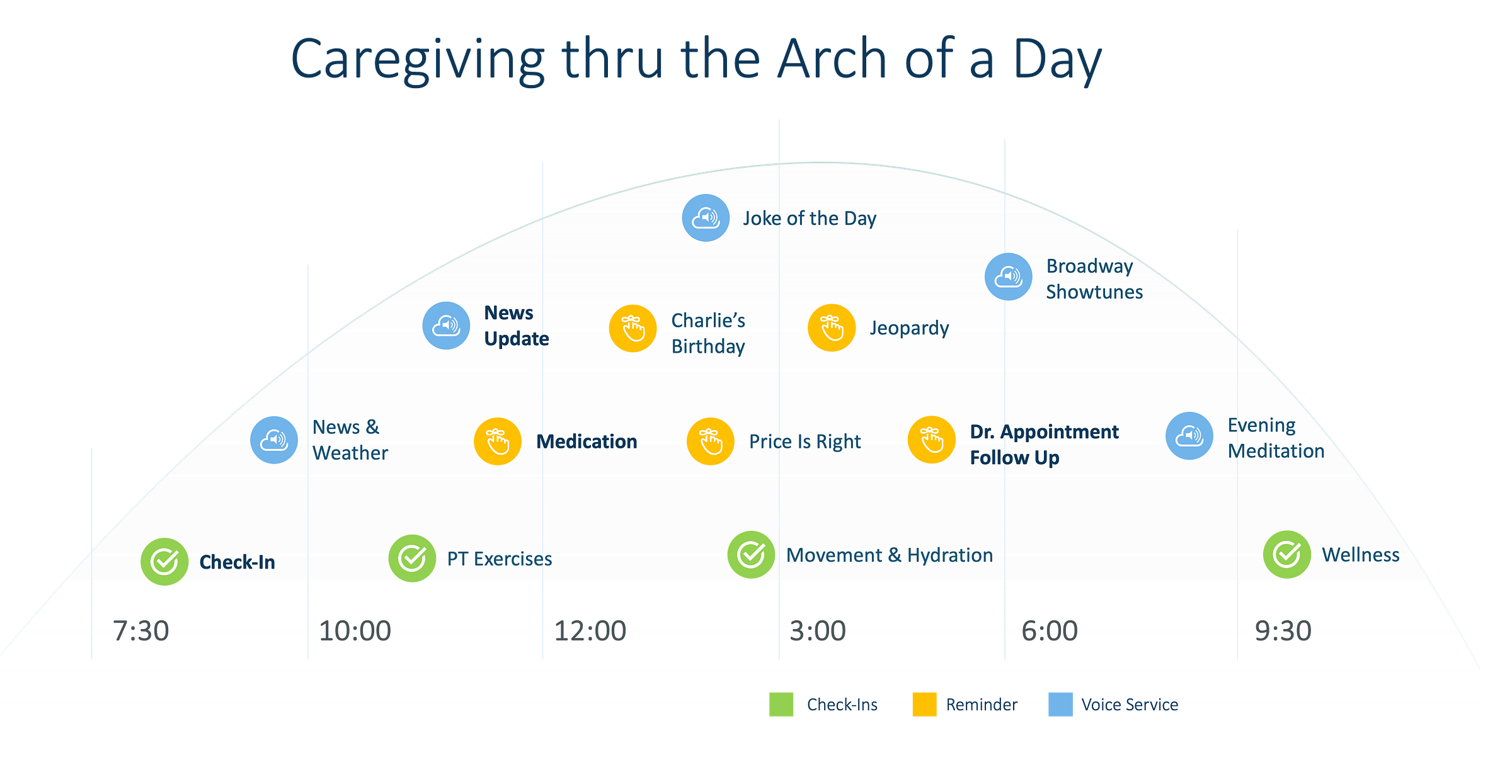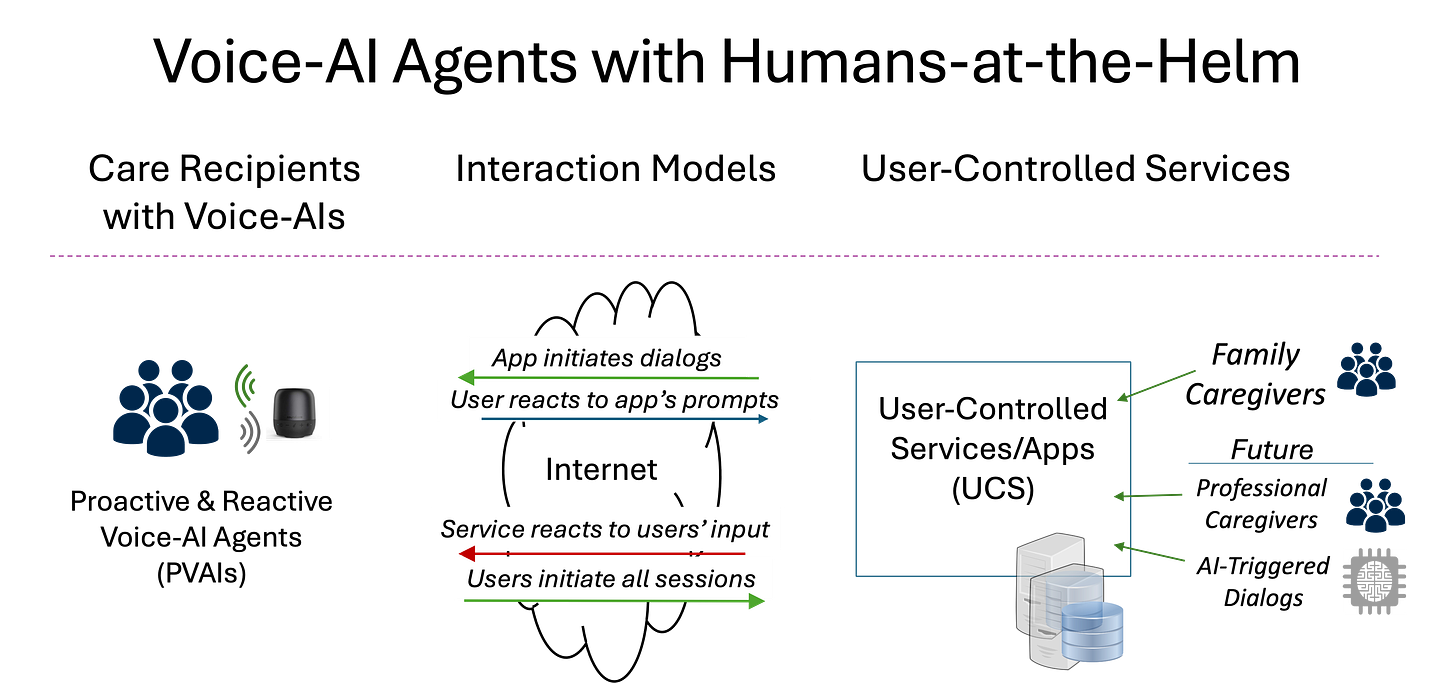The virtually unlimited possibilities of a configurable AI presence
Introductory Series • Post 3
In yesterday’s post, we explored why the web works brilliantly for self-care but fails caregivers who need to support someone else. Today, we’ll show you what a caregiver-configured VAI (voice-AI agent) can actually do—and reveal the innovations that make it possible.
What a caregiver-configured VAI could do
A VAI set up by a caregiver to support a care recipient would help the caregiver by summarizing what the care recipient said and did during the day.
It would alert the caregiver—via the channel of their choice—whenever the care recipient says something (e.g., “I need help with my new meds!”) or does something (e.g., “I’ve fallen and can’t reach my phone!”) that requires immediate or in-person assistance.
An enhanced, proactive VAI could monitor a loved one virtually around-the-clock and collect data on behalf of a caregiver. The potential types and uses of such data are expanding daily.
Certain data, for example, could trigger critical alerts, while other data would support the creation and modification of care plans tailored to each care recipient’s unique needs—all easily configurable by the caregiving team.
A VAI that speaks first
Imagine configuring a remote VAI to proactively talk with your loved one about things you think matter, at times you think are best. For example, your VAI might say:
Good evening, Carol, don’t forget to leave the light on in the bathroom in case
you need to get up during the night. We don’t want you to fall … sleep well!
or
Good morning, Carol! I wanted to remind you that today is Jenny’s birthday—your granddaughter! Would you like me to set up a call for 3 PM so you can wish her a happy birthday?!
The first example might prevent your mother, who lives alone, from falling—again. The second might delight her because dementia means she wouldn’t have remembered Jenny’s birthday otherwise—and she might have struggled to schedule the call even if she did!
The graphic below illustrates the variety of check-ins, reminders, streaming content, and smart-home tasks that a caregiver could configure for a proactive VAI to guide and comfort a care recipient throughout each day.
A voice-AI agent configured this way would provide companionship and structure to the daily life of a remote relative or friend while giving them a feeling of connection and support from their loved ones.
The missing piece
Despite recent innovations like Small Language Models and Action Models (SLMs and SAMs) that enable friendly voice chatbots to talk with users about a variety of topics, no such proactive VAI exists today—one designed to serve aging or chronically ill persons that can be configured by a caregiver or caregiving team.
Reimagining the online model for the greater good—caregiving
Given the internet’s legacy self-service model, today’s voice chatbots only react to and engage with us when we open a mobile app or visit a website. Put simply, today’s apps can’t initiate an interaction with another end-user, regardless of who it is.
Our proposed solution does exactly that:
It enables VAIs to speak proactively to care recipients—with the emotional intelligence and agency of their caregivers—so caregivers can monitor and support someone else 24/7 when they can’t be there in person.
While it may surprise some, this capability is not only possible but straightforward with today’s technology.
The next graphic shows how this new e-care model extends the legacy e-consumption model to support configurable, proactive VAIs for caregivers.
This new model incorporates two key extensions of the legacy web model.
First: Proactive Voice-AI Agents (PVAIs)
Care recipients, shown on the left, can communicate effortlessly and exclusively via voice largely because the VAI no longer waits for them to “wake it up” before engaging.
Instead, it proactively starts dialogs with the care recipient—on behalf of their caregiver—throughout the day. We call this new interface a “proactive voice-AI agent” or “PVAI” to distinguish it from today’s reactive-only VAIs.
Second: User-Controlled Services (UCS)
An individual caregiver or caregiving team, shown on the right side of the graphic, can provide the agency and the intelligence that the PVAI lacks in the form of scheduled dialogs tailored to both their own needs and those of the care recipient.
We call these powerful new capabilities “user-controlled services” or “UCS” to contrast them with the only online model we’ve ever known: host-controlled services (HCS).
Today, we introduced two innovations—PVAIs and UCS—that finally make the web work for caregivers and care recipients alike. Tomorrow, we’ll explore how these innovations work in more depth and show how other stakeholders and technologies can supplement and support the family circle of care.


